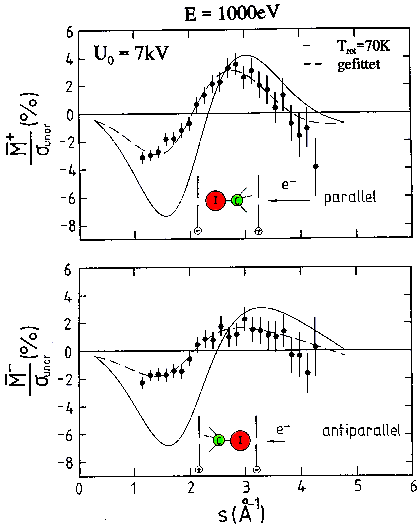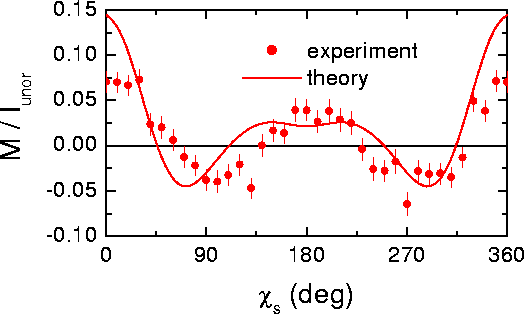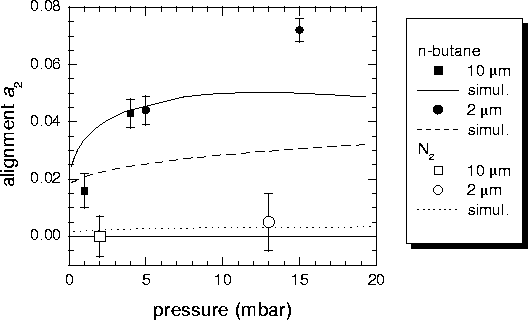

|
|
|
|
PD Dr. Norbert Böwering
Dipl. Phys. Christian Meier
Dr. Matthias Volkmer
(now with Deutsches Patentamt, Munich, Germany)
Dipl. Phys. Jürgen Lieschke
(now with GeNUA, Kirchheim, Germany)
Dipl. Phys. Rüdiger Dreier
(now with Bruker Daltonik GmbH, Bremen, Germany)
Prof. Manfred Fink
(The University of Texas at Austin)
Prof. Richard Mawhorter
(Pomona College, Claremont)
Using elastic electron scattering we study the diffraction patterns from molecules which are oriented in the gas phase. Different methods are employed both for generating the molecular orientation or alignment and also for the detection of the scattered electrons:
Due to the linear Stark effect, molecules with an electric dipole moment (in
particular symmetric top molecules like the methyl halides in our case) will
encounter a deflecting force in an electrostatic
hexapole
field. Depending on the signs of their
rotational quantum numbers,
molecular states |JKM> will
either be focussed or defocussed. In addition, the magnitude of the focussing
force depends on the particular quantum numbers J, K and M for each state. By
means of suitably chosen hexapole voltage and apertures a preferential
selection of rotational states can be achieved.
The angular distribution of the
scattered electrons is measured using a supersonic molecular beam with a
hexapole in combination with an
electron scattering unit.
It was demonstrated
that the angular distributions of diffracted electrons are significantly
different from the case of unoriented molecules when the molecules were
oriented preferentially parallel or anti-parallel to the electron beam
direction.

As a function of transferred momentum s, the figures show the
relative deviation of the scattering intensity for these molecular orientations
with respect to the scattering from unoriented molecules.
In a second step, the molecules were oriented preferentially perpendicular to the electron beam. In that case the angular distribution of the scattered electrons is in addition no longer rotationally symmetric, as seen in the following figure:

Again, the relative deviation of the scattering intensity from the unoriented
configuration is shown, in this case as a function of the azimuthal angle.
Here, a method is applied where molecules are aligned during the expansion through capillary nozzles into vacuum. We make use of the filtering effect by molecular collisions due to the differences in the geometric collision cross sections for molecules rotating like propellers or frisbees with respect to their propagation direction. Although providing only small degrees of alignment, this method has the advantage that high molecular beam intensities can be reached. In the context of these studies, the electron diffraction methods are employed to detect the degree of alignment for different expansion conditions. In agreement with model calculations of the filter effect, the results show an increase of the measured alignment parameters with nozzle pressure for the case of n-butane while no significant alignment was detected for nitrogen molecules:

In order to improve the very time-consuming point-wise data acquisition of the scattering distributions with a rotatable detector we are developing a two-dimensional detection scheme where the complete diffraction pattern can be detected simultaneously for a whole angular range. To achieve this, the scattered electrons are detected and amplified spatially resolved by a multichannel plate and then accelerated onto a phosphor screen. This image is recorded by a CCD camera and processed further using a PC. The arrangement is shown schematically in the next figure.

|
|
Contact: Christian Meier chmeier@physik.uni-bielefeld.de Last modified: Fri Sep 10 10:21:06 CEST 2004 |

|
Wir haben auf unseren Seiten Hyperlinks zu anderen Seiten im Internet
gelegt, deren Webmaster wir nicht sind. Für alle diese Hyperlinks
gilt: Wir erklären hiermit ausdrücklich, dass wir keinerlei
Einfluss auf die Gestaltung und Inhalte dieser Seiten haben. Deshalb
"distanzieren"
wir uns hiermit von allen Inhalten dieser Seiten und machen uns ihre
Inhalte in keiner Weise zu Eigen.
©2001
Molekül- und Oberflächenphysik
|

|
|
|
|